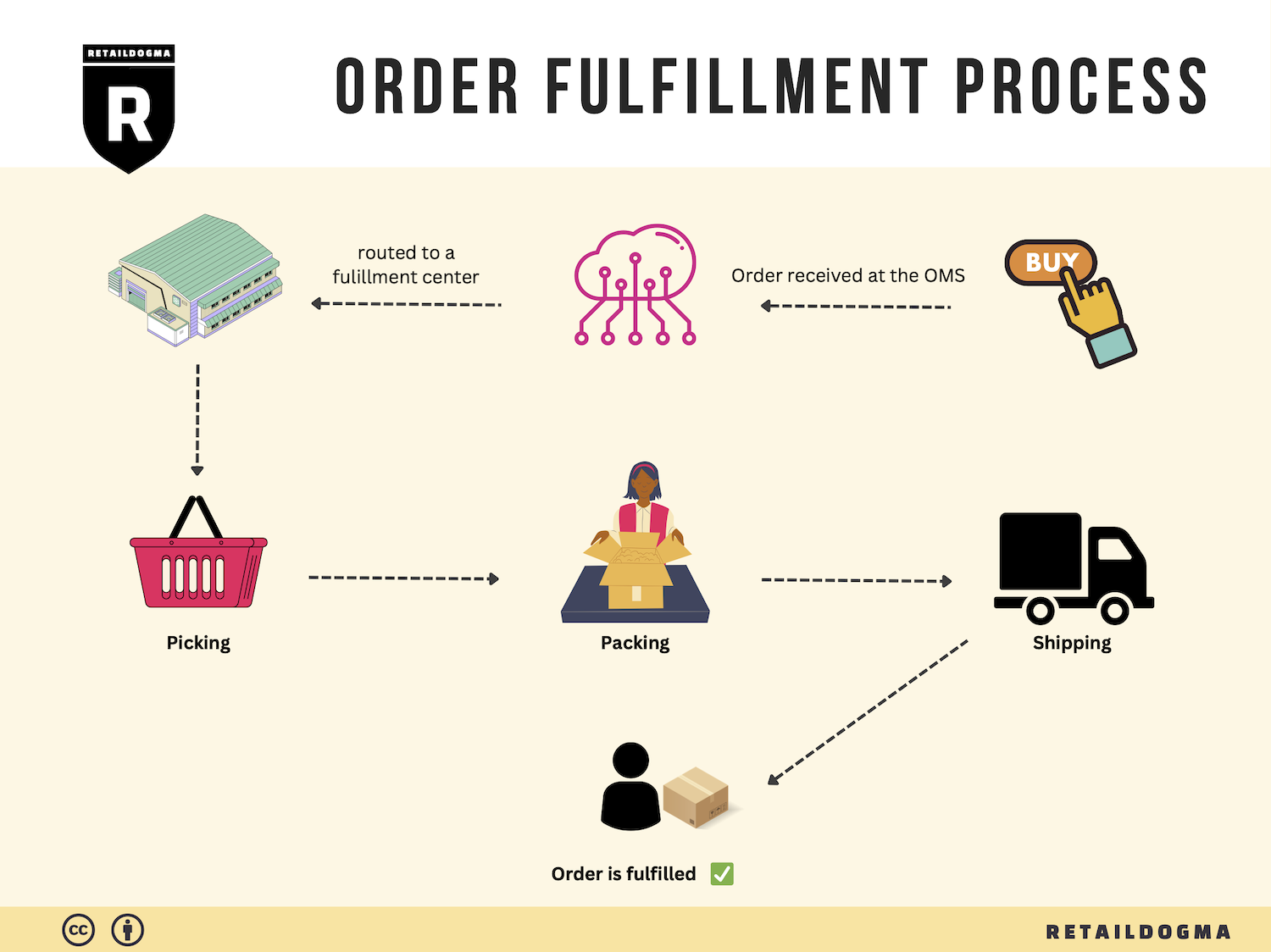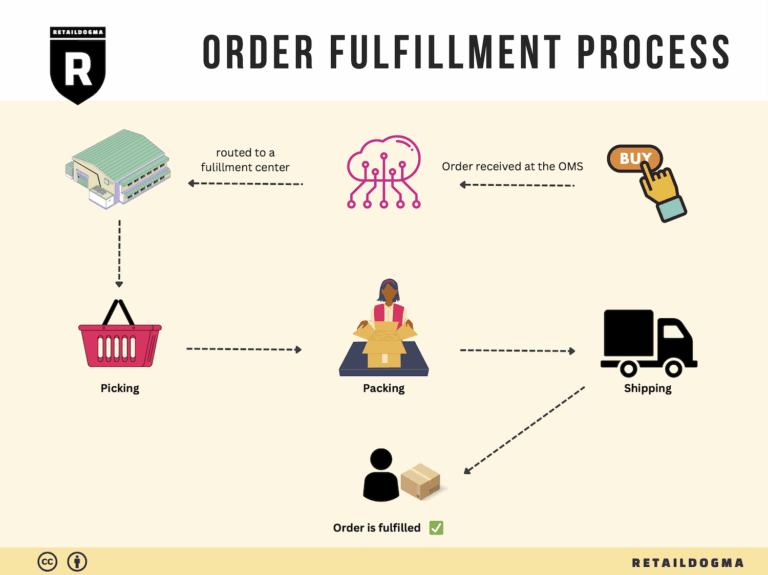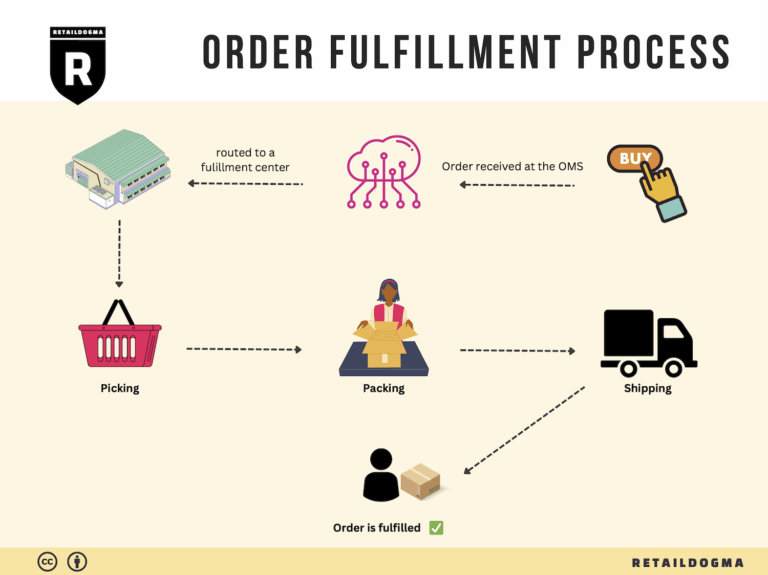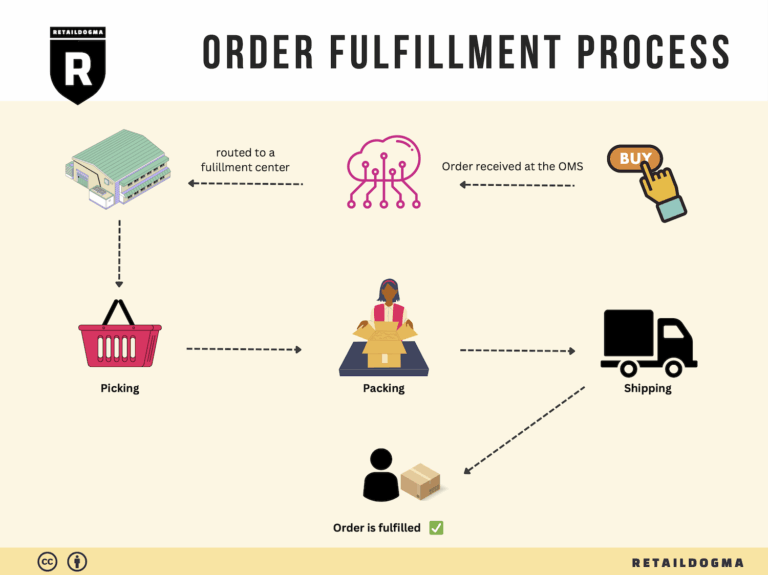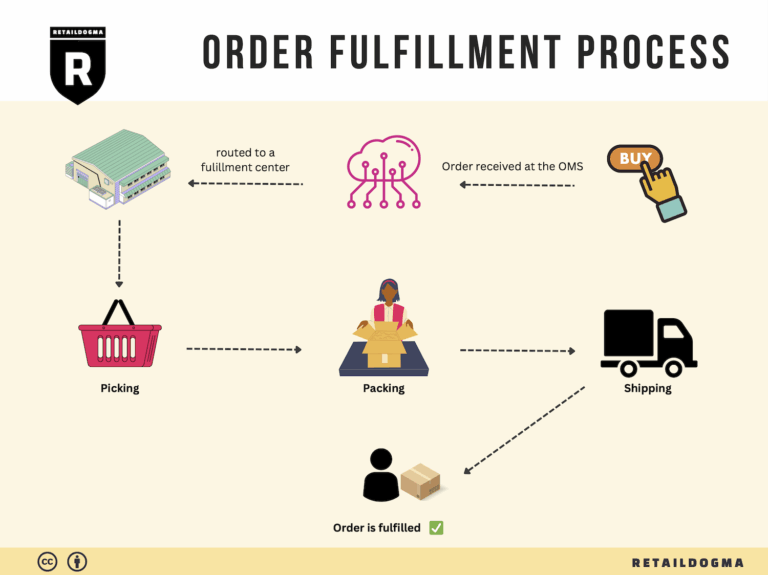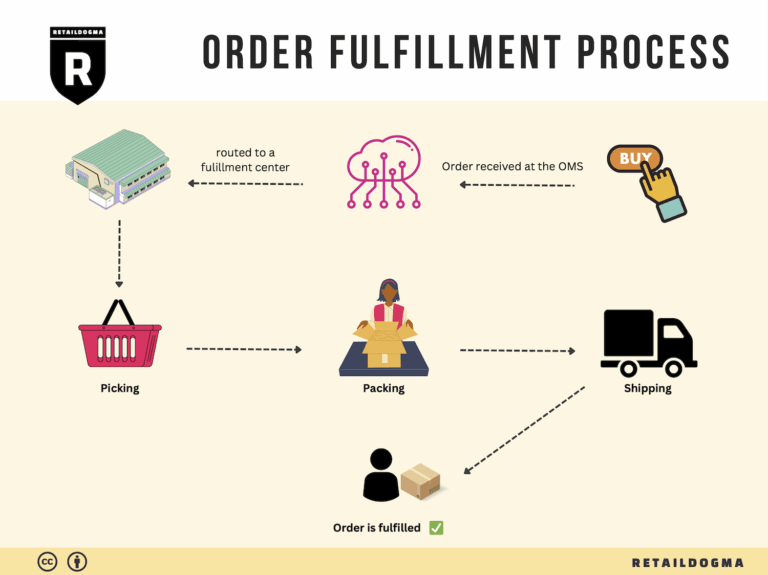Ecommerce Fulfillment Services: The Ultimate Guide (2025)
What is E-commerce Fulfillment? An Introduction for Growing Businesses
Understanding E-commerce Fulfillment
As an e-commerce business owner, you may find yourself overwhelmed with the logistical demands of packing and shipping orders. While focusing on growing your brand and attracting customers, the complexities of fulfillment can quickly become a significant pain point. Fulfillment is simply the process of getting a product from your inventory into the hands of your customer, encompassing everything from order processing to shipping and delivery. As your business expands, mastering this process becomes critical for maintaining customer satisfaction and operational efficiency.
In this guide, we will explore the essential aspects of e-commerce fulfillment that can empower your business to make informed decisions about your logistics strategy. We will begin by examining the various fulfillment models available, including third-party logistics (3PL) and Fulfillment by Amazon (FBA). Each model offers distinct advantages and challenges, and understanding these can help you choose the right one for your business needs.
Next, we will delve into the core services that are integral to effective fulfillment. This includes warehousing, inventory management, order processing, packing, shipping, and returns handling. Each service plays a vital role in ensuring that your products reach customers quickly and accurately, which is crucial for building a loyal customer base.
Choosing the right fulfillment partner is another critical decision for growing businesses. In this guide, we will provide practical tips for evaluating potential partners, including assessing their technology capabilities, service offerings, and track record in the industry. A well-chosen partner can streamline your operations and allow you to focus more on strategic growth initiatives.
Finally, we will discuss pricing considerations associated with different fulfillment options. Understanding the cost structures involved will enable you to budget effectively and maximize profitability as you scale your operations.
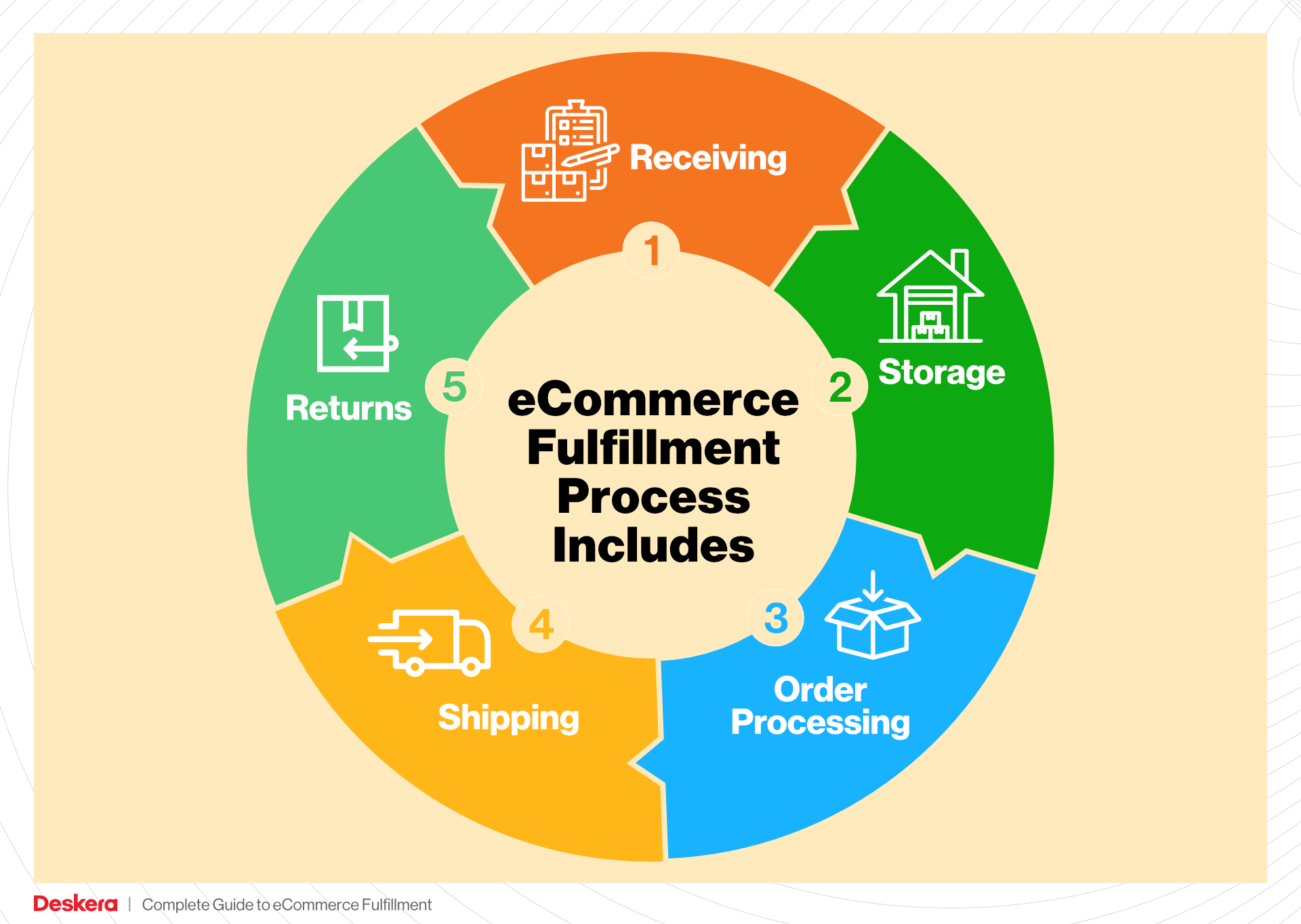
The goal of this guide is to empower you, as a growing business, to navigate the complexities of e-commerce fulfillment with confidence. By equipping you with the knowledge and insights needed to make smart decisions about logistics, we aim to help you enhance your operational efficiency, improve customer satisfaction, and ultimately drive sales growth. Let’s embark on this journey to simplify and optimize your fulfillment processes.
What You’ll Learn In This Guide
- What is E-commerce Fulfillment? An Introduction for Growing Businesses
- The Order Fulfillment Process: From ‘Buy’ Button to Customer’s Door
- Comparing Fulfillment Models: In-House vs. 3PL vs. Dropshipping
- A Deep Dive into Amazon FBA: Pros, Cons, and Who It’s For
- Core Services Offered by Fulfillment Centers
- How to Choose a Fulfillment Partner: A 6-Point Checklist
- Understanding Fulfillment Pricing: A Breakdown of Common Fees
- Frequently Asked Questions (FAQs) about Fulfillment
- Conclusion: Is Outsourcing Fulfillment the Right Move for Your Business?
- Important Disclaimer
The Order Fulfillment Process: From ‘Buy’ Button to Customer’s Door
1. Receiving Inventory
The order fulfillment process begins with receiving inventory, which is a crucial step in maintaining a smooth supply chain. When products arrive at your warehouse, they must be checked for accuracy against purchase orders to ensure that the correct items and quantities have been delivered. This process involves inspecting the goods for any damages and verifying that the shipment meets quality standards.
Importance: Proper receiving practices help prevent stock discrepancies and ensure that your inventory levels are accurate, which is vital for efficient order processing. This step is also where you assign a Stock Keeping Unit (SKU) to each product, which simplifies tracking and management throughout the fulfillment process.
Key Term: SKU (Stock Keeping Unit) – A unique identifier for each product that aids in inventory management and tracking.
2. Warehouse Storage
Once inventory is received and verified, the next step is warehouse storage. Efficiently organizing your warehouse is essential for optimizing space and ensuring easy access to products. Items should be stored based on their size, weight, and frequency of sale, often utilizing a systematic layout such as FIFO (First In, First Out) to manage perishable goods effectively.
Importance: Effective storage solutions not only maximize warehouse space but also reduce the time required to locate products during the picking process. This can significantly enhance your overall operational efficiency and reduce labor costs.
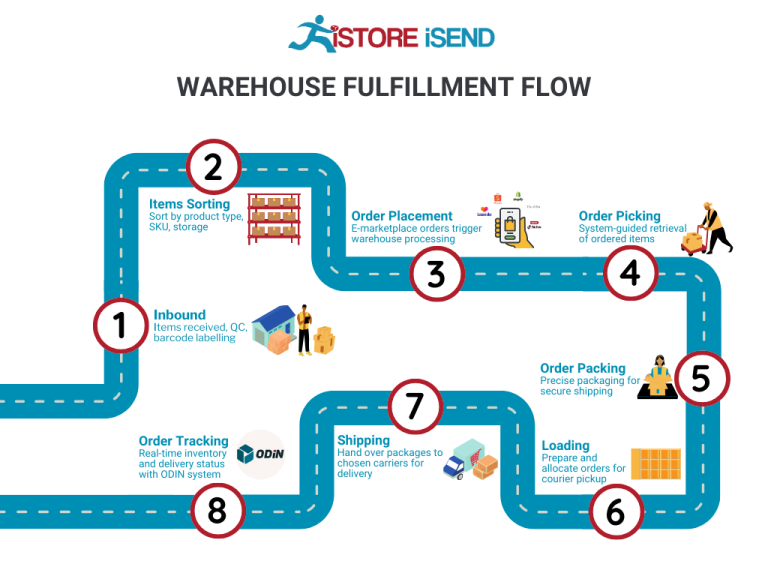
Key Term: FIFO (First In, First Out) – A method of inventory management that ensures older stock is sold before newer stock, particularly important for perishable items.
3. Order Picking
Order picking is the process of selecting and gathering items from the warehouse to fulfill customer orders. Once an order is placed, warehouse staff use pick lists—documents that outline which items need to be collected for specific orders. This step can be executed through various methods, including single order picking (one order at a time) or batch picking (multiple orders at once), depending on the volume of orders and efficiency needs.
Importance: The accuracy of order picking directly impacts customer satisfaction and operational costs. Mistakes during this phase can lead to incorrect orders, returns, and increased shipping costs. Therefore, investing in training and technology, such as barcode scanners or pick-to-light systems, can enhance picking accuracy.
Key Term: Pick List – A document that indicates which items to retrieve for fulfilling a customer order, serving as a guide for warehouse staff.
4. Order Packing
After items have been picked, they move to the packing stage. This involves securely packing products for shipment, ensuring they are protected during transit. Proper packing materials and techniques are essential to minimize damage and maximize shipping efficiency. It’s also important to include packing slips and any promotional materials that may enhance customer experience.
Importance: Effective packing ensures that products arrive at their destination in perfect condition, which is vital for maintaining a positive brand image. Additionally, optimizing packing can lead to better shipping rates and reduce the overall shipping footprint by minimizing wasted space.
Key Term: Packing Slip – A document included in the package that lists the items enclosed, serving as a receipt for the customer and a checklist for the warehouse staff.
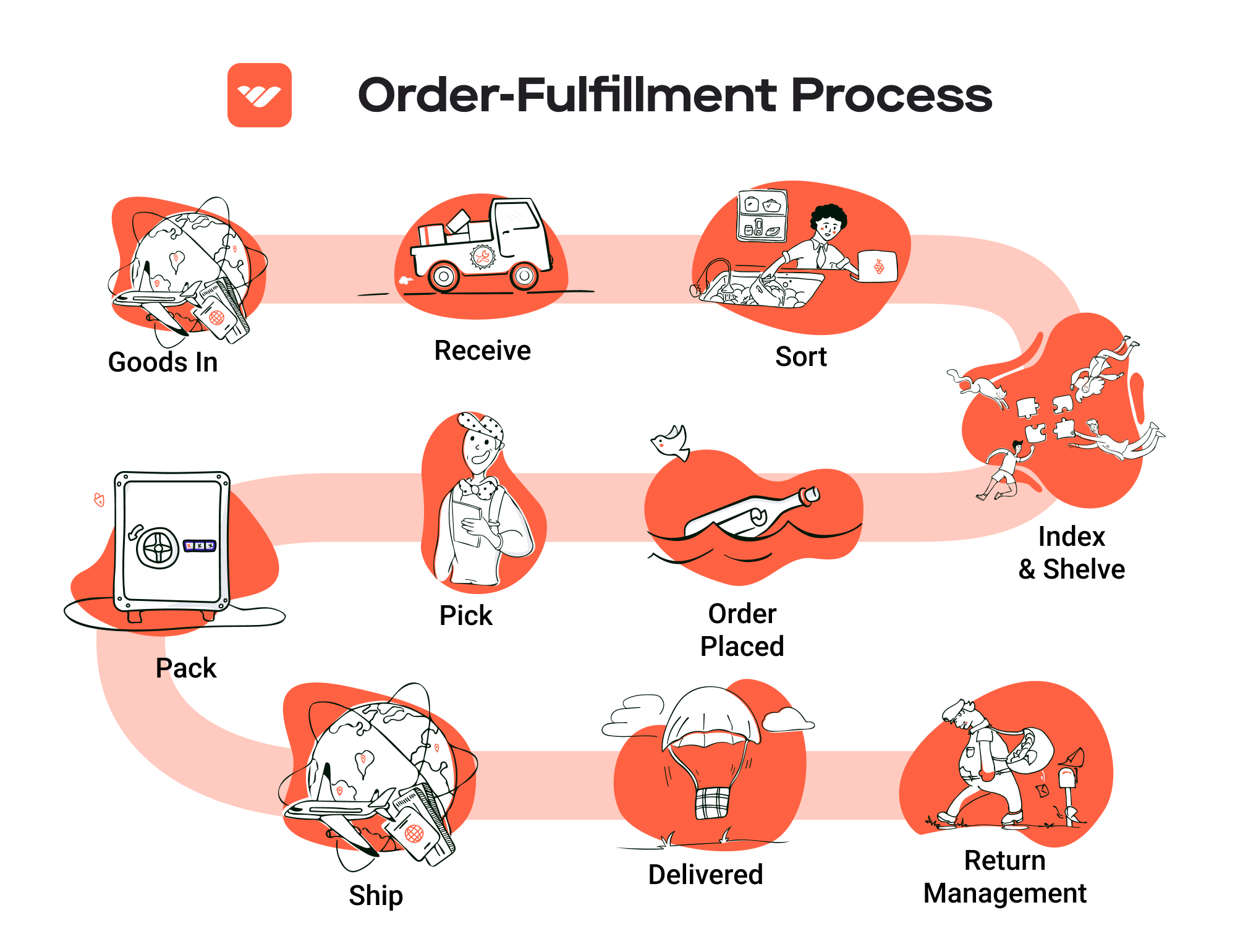
5. Shipping & Delivery
The final step in the order fulfillment process is shipping and delivery. Once orders are packed, they are prepared for dispatch. Choosing the right shipping carriers and methods is critical for meeting customer expectations regarding delivery times and costs. Implementing tracking systems allows both the business and the customer to monitor the shipment’s progress.
Importance: Timely and accurate delivery is a significant factor in customer satisfaction and loyalty. By optimizing shipping processes and leveraging technology for real-time tracking, businesses can enhance the overall customer experience and streamline logistics operations.
Key Term: Tracking System – A technology that allows both businesses and customers to monitor the status of shipments in real time, providing transparency and enhancing customer service.
By understanding and optimizing each step in the order fulfillment process, e-commerce businesses can improve operational efficiency, reduce costs, and enhance customer satisfaction, which are all critical for scaling successfully in a competitive marketplace.
Comparing Fulfillment Models: In-House vs. 3PL vs. Dropshipping
Comparison of Fulfillment Models
| Model | Who Handles Inventory | Best For (Business Stage) | Key Advantage | Key Disadvantage |
|---|---|---|---|---|
| In-House Fulfillment | Business itself | Established businesses | Full control over operations and quality | High overhead costs and resource requirements |
| Third-Party Logistics (3PL) | External logistics provider | Growing businesses | Scalability and reduced operational burden | Less control over inventory and shipping |
| Dropshipping | Supplier | Startups and small brands | Low upfront investment and risk | Lower profit margins and reliance on suppliers |
In-House Fulfillment
In-house fulfillment involves managing the entire logistics process internally. This means your business handles inventory management, order processing, and shipping directly. Typically suited for established businesses with a steady volume of orders, in-house fulfillment offers the advantage of complete control over every aspect of the operation. Companies can ensure quality standards are met, maintain brand consistency, and respond quickly to customer inquiries or issues. However, this model comes with significant drawbacks. The overhead costs can be high, as businesses must invest in warehouse space, staffing, technology, and inventory management systems. Additionally, scaling operations can be challenging, as it requires additional investments in resources and infrastructure. For businesses with fluctuating demand, maintaining an in-house operation can lead to excess inventory or stockouts, impacting customer satisfaction.
Third-Party Logistics (3PL)
Third-party logistics (3PL) providers are external companies that manage logistics on behalf of businesses. This model is ideal for growing companies that require flexibility and scalability in their operations. 3PLs handle everything from warehousing to shipping and can often leverage their established networks to reduce shipping costs and delivery times. They also provide businesses with access to advanced technology and expertise in logistics management, allowing companies to focus on core competencies like marketing and product development. However, the reliance on a 3PL can lead to challenges in maintaining control over inventory and shipping processes. Businesses may face communication issues or discrepancies in service levels, which can affect customer satisfaction. Additionally, partnering with a 3PL often involves contractual obligations and fees, which can add to operational costs.
Dropshipping
Dropshipping is a fulfillment model where a business sells products without holding inventory. Instead, when a customer places an order, the business purchases the item from a third-party supplier, who then ships it directly to the customer. This model is particularly attractive for startups and small brands, as it requires minimal upfront investment and allows for a broad product selection without the risk of excess inventory. Since businesses do not handle the physical products, they can quickly adapt to market trends and consumer demands. However, dropshipping presents significant challenges, including lower profit margins due to reliance on suppliers and potential issues with product quality and shipping times. Businesses must also invest time in vetting suppliers and managing relationships to ensure a consistent customer experience. Additionally, the lack of control over inventory can lead to stockouts and fulfillment delays, which can harm customer trust and brand reputation.
Conclusion
Choosing the right fulfillment model is crucial for businesses looking to scale their operations effectively. Each model—whether in-house, 3PL, or dropshipping—offers distinct advantages and disadvantages that must be carefully weighed against the company’s specific needs, growth stage, and market dynamics. Businesses should consider their operational capabilities, financial resources, and customer expectations when selecting a fulfillment strategy, as this decision will significantly influence their ability to meet demand and drive growth in a competitive landscape.
A Deep Dive into Amazon FBA: Pros, Cons, and Who It’s For
Understanding Fulfillment by Amazon (FBA)
Fulfillment by Amazon (FBA) is a service offered by Amazon that allows sellers to store their products in Amazon’s fulfillment centers. Amazon then takes care of storage, packaging, and shipping, along with customer service and returns for those products. This service enables sellers to leverage Amazon’s extensive logistics and customer service capabilities, helping them scale their businesses more efficiently.
How FBA Works
When a seller enrolls in FBA, they send their products to Amazon’s warehouses. Once the inventory is received, Amazon takes over the management of those products. Here’s a step-by-step breakdown of the FBA process:
-
Product Listing: Sellers create product listings on Amazon and choose FBA as their fulfillment method.
-
Shipping to Amazon: Sellers prepare their products and ship them to designated Amazon fulfillment centers. Amazon provides guidelines on packaging and labeling to ensure products are ready for storage.
-
Storage: Once received, products are stored in Amazon’s warehouses. Sellers can monitor their inventory levels through the Seller Central dashboard.
-
Order Processing: When a customer places an order, Amazon picks, packs, and ships the product directly to the customer.
-
Customer Service: Amazon handles all customer inquiries and returns, allowing sellers to focus on other aspects of their business.
-
Payment: After an order is fulfilled, Amazon collects payment from the customer, deducts applicable fees, and transfers the remaining balance to the seller.
Pros of Using FBA
1. Prime Eligibility
One of the most significant advantages of using FBA is that products become eligible for Amazon Prime. This can dramatically increase visibility and sales, as Prime members often prioritize Prime-eligible products due to the benefits of free two-day shipping.
2. Customer Trust
Amazon is a trusted brand, and products fulfilled by Amazon benefit from this reputation. Customers are more likely to purchase from sellers using FBA because they know they will receive reliable service and support.
3. Multi-Channel Fulfillment
FBA is not limited to Amazon sales. Sellers can use FBA to fulfill orders from other sales channels, such as their own e-commerce websites. This multi-channel fulfillment capability streamlines logistics and inventory management.
4. Scalable Operations
FBA allows businesses to scale without the need to invest heavily in warehousing and logistics. Sellers can focus on growing their product lines and marketing their brands while Amazon manages the fulfillment process.
5. Automated Returns
Amazon handles returns for FBA orders, simplifying the process for sellers. This not only saves time but also enhances the customer experience by providing a straightforward return policy.
Cons of Using FBA
1. High Fees
While FBA provides many benefits, it comes at a cost. Sellers must pay storage fees, which can accumulate over time, especially for slow-moving inventory. Additionally, there are fulfillment fees for each item sold, which can significantly impact profit margins.
2. Strict Inventory Rules
Amazon has strict guidelines regarding inventory management. Sellers must adhere to these rules, including maintaining adequate stock levels to avoid penalties. Failure to comply can result in additional fees or account restrictions.
3. Commingling Risks
When using FBA, sellers’ products can be commingled with those of other sellers. This means that if a customer receives a defective or damaged product, it can be challenging to pinpoint accountability. This risk can impact brand reputation and customer satisfaction.
4. Limited Control
Sellers relinquish a degree of control over their fulfillment process. Amazon’s policies dictate many aspects of how products are stored, packaged, and shipped. This can be a drawback for brands that prioritize a specific customer experience.
5. Inventory Management Challenges
While FBA offers convenience, it also introduces complexity in inventory management. Sellers must regularly monitor their inventory levels in Amazon’s warehouses and ensure they have sufficient stock to meet demand without incurring excessive storage fees.
Who is FBA Best For?
Fulfillment by Amazon is particularly well-suited for:
-
Small to Medium-Sized Businesses: Businesses looking to scale quickly without investing heavily in logistics can benefit from FBA’s infrastructure and reach.
-
Sellers with High Volume: Businesses that sell products with a high turnover rate can leverage FBA to maximize efficiency and minimize storage costs.
-
Brands Seeking Trust: New sellers or those with less brand recognition can gain credibility by utilizing Amazon’s trusted fulfillment network.
-
Multi-Channel Sellers: Businesses that sell on various platforms can streamline operations by using FBA for all their fulfillment needs.
-
Entrepreneurs Focused on Growth: Sellers wanting to focus on marketing and product development rather than logistics will find FBA to be a valuable solution.
In conclusion, Fulfillment by Amazon offers significant advantages for e-commerce sellers, but it’s essential to weigh these against the potential drawbacks. By understanding how FBA works and its implications for business operations, sellers can make informed decisions that align with their growth strategies.
Core Services Offered by Fulfillment Centers
Inventory Management & Warehousing
Inventory management and warehousing are foundational services provided by fulfillment centers. This service involves the systematic tracking and control of stock levels, ensuring that products are stored efficiently and are easily accessible for order fulfillment.
What It Is: Fulfillment centers utilize advanced inventory management systems to monitor stock levels in real-time, manage reordering processes, and maintain optimal inventory levels. Products are stored in organized warehouses, often with specific shelving and labeling systems that facilitate quick retrieval.
Benefits for E-commerce Businesses: Effective inventory management minimizes the risks of stockouts and overstock, which can lead to lost sales or increased holding costs, respectively. By maintaining optimal inventory levels, businesses can respond swiftly to customer demand, improving customer satisfaction through timely deliveries. Additionally, real-time inventory tracking provides valuable insights into sales trends and product performance, enabling better forecasting and strategic planning.
Pick and Pack Services
Pick and pack services are crucial for the efficient processing of customer orders. This service involves selecting the right products from the warehouse (picking) and packaging them appropriately for shipment (packing).
What It Is: When a customer places an order, the fulfillment center’s staff retrieves the specified items from the warehouse. After gathering the products, they pack them securely using appropriate materials to ensure safe transit. This may include using protective cushioning, custom packaging, and labeling for easy identification.
Benefits for E-commerce Businesses: The pick and pack process significantly speeds up order fulfillment times, which is essential in today’s competitive e-commerce landscape. A streamlined pick and pack operation reduces the chances of errors, such as shipping the wrong item, thus improving overall customer satisfaction. Moreover, fulfillment centers often employ automation and technology to enhance efficiency, which can lead to cost savings and higher throughput, allowing businesses to scale operations without proportionately increasing labor costs.
Kitting and Assembly
Kitting and assembly services involve the grouping of various products into a single package or kit, often for promotional or product bundling purposes. This service is particularly valuable for businesses looking to enhance their offerings or streamline their product lines.
What It Is: In kitting, fulfillment centers take different items and assemble them into a ready-to-ship kit. This can include combining multiple products into one package or preparing items for a specific promotion. Assembly may also involve putting together components that require assembly before they can be sold.
Benefits for E-commerce Businesses: Kitting and assembly allow businesses to offer unique product bundles that can drive sales and increase average order value. By simplifying the purchasing process for customers, businesses can enhance their marketing efforts and attract more buyers. Additionally, outsourcing kitting and assembly to fulfillment centers can free up internal resources, allowing companies to focus on core business activities such as product development and marketing.
Returns Management (Reverse Logistics)
Returns management, also known as reverse logistics, is an essential service provided by fulfillment centers that deals with the process of handling returned products. This service is increasingly important in the e-commerce sector due to the high return rates associated with online shopping.
What It Is: Returns management involves the systematic handling of returned goods, including processing returns, restocking items, and managing refunds or exchanges. Fulfillment centers implement efficient procedures to assess the condition of returned items, determine their disposition (such as restocking or recycling), and ensure that customer service communications are handled effectively.
Benefits for E-commerce Businesses: A well-managed returns process can significantly enhance customer satisfaction and loyalty. By making returns hassle-free, businesses can encourage repeat purchases and build a positive brand reputation. Additionally, effective returns management minimizes losses by ensuring that products are quickly restocked and made available for resale. It also provides valuable data on customer preferences and product issues, allowing businesses to refine their offerings and reduce future return rates.
Conclusion
In conclusion, fulfillment centers provide a suite of services that are critical for the success of e-commerce businesses. By leveraging inventory management, pick and pack services, kitting and assembly, and returns management, businesses can streamline operations, enhance customer satisfaction, and ultimately scale their sales and logistics effectively. As e-commerce continues to evolve, partnering with a capable fulfillment center can provide a competitive edge in a crowded marketplace.
How to Choose a Fulfillment Partner: A 6-Point Checklist
Location & Warehouse Network
Why It’s Important:
The geographical location of your fulfillment partner’s warehouses plays a crucial role in shipping efficiency and cost. Proximity to your customer base can significantly reduce delivery times and shipping expenses.
Questions to Ask:
– Where are your warehouses located, and how does that align with my target market?
– What is your average shipping time to various regions?
– Can you accommodate seasonal fluctuations in demand with your current warehouse network?
Technology & Integrations
Why It’s Important:
A fulfillment partner with robust technology solutions can streamline order processing, inventory management, and reporting. This is particularly important for e-commerce businesses that rely on real-time data to make informed decisions.
Questions to Ask:
– What technology platforms do you use for order processing and inventory management?
– How do you integrate with e-commerce platforms (e.g., Shopify, WooCommerce, etc.)?
– Can your system provide real-time inventory updates and order tracking for my customers?
Specializations (e.g., cold storage, oversized items)
Why It’s Important:
Your specific product requirements may necessitate a partner that specializes in certain areas, such as cold storage for perishables or handling oversized items. Choosing a partner that aligns with your product needs can prevent potential mishaps and ensure compliance with industry standards.
Questions to Ask:
– Do you have any specializations or certifications relevant to my products (e.g., food safety, hazardous materials)?
– What kind of storage solutions do you offer for specific needs, such as temperature-controlled environments?
– Can you handle unique packaging requirements for my products?
Scalability & Capacity
Why It’s Important:
As your business grows, your fulfillment needs will evolve. A good partner should be able to scale operations quickly to accommodate increasing order volumes without sacrificing service quality.
Questions to Ask:
– How do you manage inventory and order fulfillment during peak seasons?
– What is your current capacity for handling orders, and how quickly can you scale up if needed?
– Have you successfully supported other businesses through rapid growth? Can you provide examples?
Pricing and Contracts
Why It’s Important:
Understanding the pricing structure and contract terms is vital for budgeting and forecasting. Hidden fees can significantly affect your bottom line, so clarity on costs is essential.
Questions to Ask:
– Can you provide a detailed breakdown of your pricing structure, including shipping, storage, and handling fees?
– Are there any minimum order requirements or long-term contract commitments?
– What are your policies regarding price adjustments or additional fees for services?
Customer Support & Reviews
Why It’s Important:
The level of customer support provided by your fulfillment partner can directly impact your business operations and customer satisfaction. Positive reviews and testimonials can offer insight into their reliability and service quality.
Questions to Ask:
– What type of customer support do you offer (e.g., dedicated account manager, 24/7 support)?
– Can you provide references or case studies from current or past clients?
– How do you handle issues such as order discrepancies or shipping delays?
Conclusion
Choosing the right fulfillment partner is a critical decision that can influence your e-commerce business’s efficiency, customer satisfaction, and overall success. By following this checklist, you can ensure that you select a partner that aligns with your operational needs and growth ambitions. Take the time to evaluate each potential partner against these criteria, and don’t hesitate to ask for clarification on any points that are unclear. A strategic partnership with the right fulfillment provider can pave the way for scaling your business effectively.
Understanding Fulfillment Pricing: A Breakdown of Common Fees
Initial Setup Fees
Initial setup fees are typically charged at the beginning of a fulfillment partnership. These fees cover the costs associated with onboarding a new client, which may include system integration, account setup, and training. The exact amount can vary significantly depending on the complexity of the services required and the technology systems involved.
For example, if a business requires specialized software integration to manage inventory or order processing, the setup fee may be higher. Conversely, a straightforward integration with minimal customization will likely incur lower fees. It’s essential for businesses to understand that these upfront costs are an investment in streamlining operations and ensuring seamless service delivery.
Receiving Fees
Receiving fees are charged when products arrive at the fulfillment center. This fee covers the labor and resources needed to unload, inspect, and enter the inventory into the system. Typically calculated per shipment or per item received, these fees can vary based on the volume and type of goods.
For instance, larger shipments may have a lower per-item cost due to economies of scale, while smaller shipments could incur higher fees. Additionally, if the items require special handling or inspection, such as food safety compliance for restaurant supplies, this could further influence the receiving fee structure.
Storage Fees (per pallet/bin)
Storage fees are charged for the space occupied by products in the fulfillment center. These fees are generally calculated on a per-pallet or per-bin basis and can vary based on the duration of storage.
Most fulfillment centers offer tiered pricing based on the volume of storage required. For example, a business storing a few pallets may pay a standard rate, while those with larger inventories might benefit from reduced rates per pallet. Businesses should also consider the seasonal nature of their products; storage fees can add up if products are held for extended periods, especially during off-peak seasons.
Pick & Pack Fees (per item/order)
Pick and pack fees cover the costs associated with retrieving items from storage and packing them for shipment. This fee is usually calculated on a per-item or per-order basis. The complexity of the order can also impact the fee; for example, an order requiring multiple items or special packaging might incur a higher pick and pack fee.
Businesses should be aware that some fulfillment centers offer flat-rate pricing for pick and pack services, while others may have variable pricing based on the specifics of each order. Understanding the nuances of these fees can help businesses manage their overall fulfillment costs more effectively.
Shipping Fees
Shipping fees are incurred when products are dispatched from the fulfillment center to the customer. These fees can be influenced by various factors, including the shipping method chosen, the destination, and the weight of the package.
Fulfillment providers often have negotiated rates with carriers, which can lead to savings for businesses. However, it is crucial to factor in the shipping speed required by customers, as expedited shipping will typically incur higher fees. Additionally, businesses should consider offering multiple shipping options to customers, allowing them to choose based on their budget and urgency.
Tips for Getting an Accurate Quote
-
Provide Detailed Information: When seeking quotes, be as specific as possible about your product types, volumes, and any special handling requirements. This allows fulfillment centers to provide a more accurate estimate.
-
Understand Your Needs: Clearly outline your operational needs, including storage duration, expected order frequency, and any seasonal fluctuations. This helps in negotiating better rates.
-
Request Itemized Quotes: Always ask for itemized quotes that break down each fee type. This transparency will help you understand where costs are coming from and identify areas for potential savings.
-
Compare Multiple Providers: Don’t settle for the first quote. Comparing several fulfillment providers can give you a better sense of the market rates and available services.
-
Inquire About Discounts: Many fulfillment centers offer discounts for higher volumes or long-term contracts. Don’t hesitate to ask about potential savings.
By understanding these common fulfillment pricing models and following these tips, businesses can make informed decisions that align with their operational goals and budget constraints.
Frequently Asked Questions (FAQs) about Fulfillment
1. What is Dot It Restaurant Fulfillment?
Dot It Restaurant Fulfillment specializes in providing comprehensive print and brand fulfillment services primarily for the foodservice industry. Their offerings include sourcing, printing, kitting, order processing, warehousing, and distribution, designed to streamline operations and maintain brand consistency across multiple locations.
2. How does Dot It ensure food safety compliance?
Dot It offers specialized products such as tamper-resistant labels and food safety training materials, ensuring that their clients meet industry regulations and maintain high safety standards. Their focus on innovative solutions helps brands comply with health codes and manage risks effectively.
3. What is the difference between a warehouse and a fulfillment center?
A warehouse is primarily used for storing goods, while a fulfillment center is designed for processing orders and shipping products to customers. Fulfillment centers often incorporate technology to manage inventory, streamline order processing, and enhance customer service, making them integral to e-commerce operations.
4. What is a Third-Party Logistics Provider (3PL)?
A 3PL is a service provider that manages logistics operations for other companies, including warehousing, transportation, inventory management, and order fulfillment. Partnering with a 3PL like Dot It allows businesses to focus on their core activities while outsourcing complex logistics tasks.
5. How much do fulfillment services cost?
The cost of fulfillment services can vary significantly based on factors such as order volume, storage space, and specific service requirements. Businesses can expect to pay for storage fees, picking and packing services, shipping costs, and potentially setup fees. It’s advisable to request a customized quote based on individual needs.
6. What technology does Dot It use for fulfillment?
Dot It employs advanced eCommerce and reporting technology to facilitate centralized order management, inventory tracking, and data analytics. This technology enables businesses to streamline their operations and maintain visibility over their supply chain.
7. How can I access Dot It’s services?
Businesses can access Dot It’s services through their Branded Web Portal, which offers a user-friendly interface for placing orders, managing inventory, and tracking shipments. This platform is designed for ease of use, allowing for seamless operations at the store level.
8. What industries does Dot It serve?
While Dot It primarily focuses on the foodservice industry, they also cater to various sectors that require print and brand fulfillment services. Their expertise in food safety and branding allows them to adapt their solutions for different business needs.
9. What are the benefits of using Dot It for fulfillment?
Utilizing Dot It for fulfillment provides several advantages, including improved operational efficiency, access to specialized print solutions, enhanced brand consistency, and compliance with safety regulations. Their experience in the foodservice sector also positions them as a valuable partner for businesses looking to scale.
10. How can Dot It help businesses scale their operations?
Dot It supports businesses in scaling their operations through optimized supply chain management, innovative product offerings, and technology-driven solutions. By streamlining fulfillment processes and ensuring brand consistency, Dot It enables companies to focus on growth and customer satisfaction.
Conclusion: Is Outsourcing Fulfillment the Right Move for Your Business?
Assessing the Benefits of Outsourcing Fulfillment
Outsourcing your fulfillment process can be a game-changer for your business, especially as you aim to scale operations. One of the most compelling advantages is the significant time savings it offers. By delegating logistics, inventory management, and order processing to a specialized fulfillment partner, you can redirect your focus towards core business functions like product development and marketing. This shift not only enhances productivity but also ensures that your team can respond more effectively to customer needs.
Scalability is another critical benefit of partnering with a fulfillment service. As your business grows, so do the complexities of managing logistics. A proficient fulfillment partner provides the necessary infrastructure to handle increased order volumes without the need for substantial investment in warehousing or staffing. This adaptability allows you to maintain consistent service levels, regardless of fluctuations in demand.
Furthermore, tapping into the expertise of a fulfillment partner can elevate your operations. With industry knowledge and advanced technology solutions, these partners can optimize your supply chain, reduce shipping errors, and enhance overall customer satisfaction. Their experience in navigating the intricacies of logistics means you can benefit from best practices that may not be readily available in-house.
However, the success of this strategy hinges on choosing the right fulfillment partner. The ideal partner should align with your business goals, offer tailored solutions, and possess a track record of reliability and efficiency.
To determine if outsourcing fulfillment is the right move for your business, conduct a thorough audit of your current shipping processes. Evaluate your pain points and consider whether the advantages of outsourcing can address these challenges. Taking this step could pave the way for growth and operational excellence in your e-commerce journey.
Important Disclaimer
⚠️ Important Disclaimer
The information in this guide is for educational purposes. Fulfillment services, pricing, and platform features change frequently. Always conduct your own due diligence and consult with providers directly before making business decisions.
